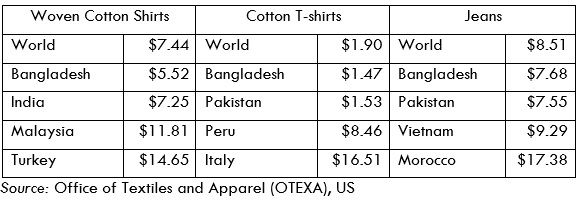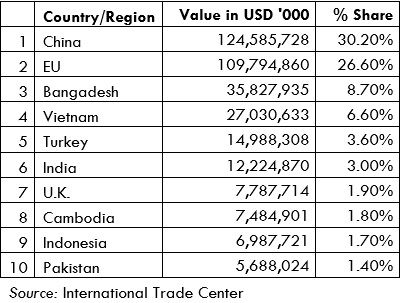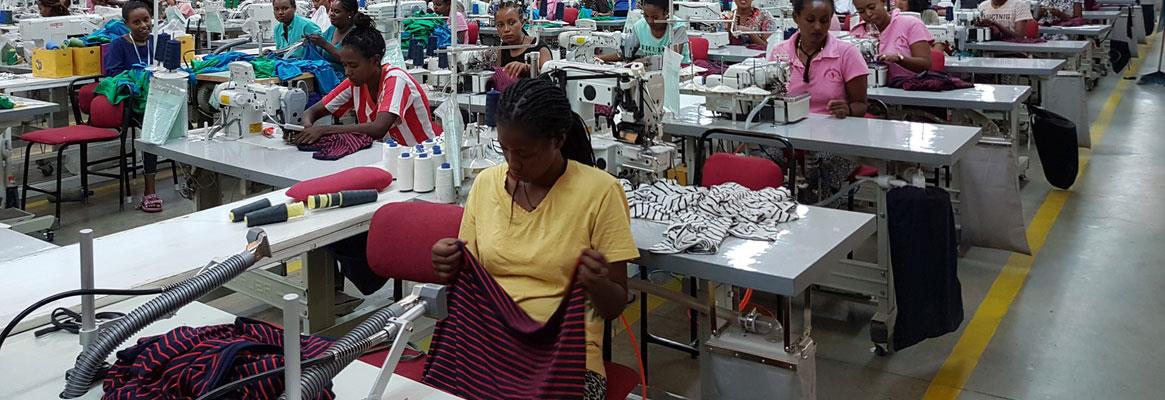We work in what is without a doubt the world’s most globalised industry—the garment industry. At last count, there were more garment exporting countries and territories than members of the United Nations (230 compared with 193). I am sure that Tierra Del Fuego — at the very bottom of South America — is home to garment exporting factories; and I am equally sure that there exist at least some importers who swear that Tiera Del Fuego is the place to buy skirts.
Garments are sold everywhere and produced everywhere. We are told that Ethiopia will be the next place to buy garments. This is a country where six years ago there were zero garment factories and had no decent road network. It is a landlocked country, where goods would have to travel next door to Eritrea to ship the stuff and where the shipping cost of a container was in excess of $10,000. Yet, smart and knowledgeable people have invested large sums to build a textile/garment industry from the ground up. (You might ask why? Down the line, this might make a good puzzle.)
I am sure that at this very moment there are customers and suppliers who are looking at the upside of global warming. “Let’s set up in Antarctica, which has potentially an almost unlimited source of cheap labor, provided we can teach the Penguins to sew.”
Humor notwithstanding, we garmentos buy everywhere, sell everywhere, and produce everywhere. Yet so many of us perceive our industry as something local.
They complain, why do customers pay so little, FOB prices below cost? These serious concerns are for the most part concentrated in the mass-market commodity garment sector.
To understand the problem, much less find a solution, those complaining must look outside their factory to the global garment world.
1. The customer: If you are in the mass-market commodity garment business, your customers are limited only to those in the mass-market commodity garment business or other customers coming to you for mass-market commodity goods. Of course, they pay you less because that is why they came to you in the first place.
2. The product: It is not the product. The fact that your factory produces woven cotton shirts, cotton t-shirts or jeans does not automatically put you in the cheap commodity sector. Indeed, the same product may be a cheap mass-market commodity to some or a high value-added fashion garment to others depending on your factory. Look at the world. Look at the FOB prices customers are paying you and what they are paying others. Ask yourself, why them and not me?
Table 1: Average FOB Price Per Piece

3.The sector: This is the most difficult issue. Sixty years ago, when our industry was just getting started, we were all making cheap mass-market commodities. At that time, the customer was king. This was truly a buyers’ market, where every factory was replaceable. The customer wanted cheap garments. We gave him cheap garments. So what, if to meet his demands we paid our people the lowest wages, required excessive overtime while forcing them to work in terrible and often unsafe conditions. For us, every day was a fight for survival.
Those days are long gone. Today we live in a world where FOB price is no longer that important. This may be hard to accept, but once you look at the garment industry with a world view, the data is clear. The top two garment exporters, neither of which are cheap labour, account for 56.8 per cent of total garment exports.
Table 2: Top 10 Garment Exporting Countries 2020

Today, we on the supplier side are operating in a segmented market.
At the top there are strategic suppliers: Factories that produce special products, special quality and/or special services are in great demand. Their customers will not only pay a premium price, but more importantly will guarantee orders 11.5 months a year.
The second echelon are full-service suppliers: Factories that have moved from being simple garment makers to more sophisticated service providers. Customers pay them a premium because those services greatly reduce customers’ costs.
At the bottom are the zero-service suppliers: Factories that remain garment makers. These are concentrated in the cheap mass-market commodity sector.
That sector is in a state of secular decline.
On the one hand, as new countries in Western Asia and Africa move into the garment export industry, they can produce only cheap commodities, thus increasing the number of suppliers.
On the other hand, young consumers’ demands for low-priced fashion has created a new sector. Think BooHoo and Shein. These are but two highly successful operations that collectively are reducing demand for commodity garments.
Those in the cheap mass-market commodity garment sector have become trapped.
Today, too many factories are chasing too few customers, while at the same time too many customers are chasing too few consumers.
Regrettably, the data is clear. Those trapped in the commodity garment sector must get out and move up to higher value-added fashion garments. This will not be easy and most certainly it will not be cheap. However, it will be unavoidable.









Comments